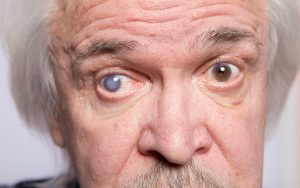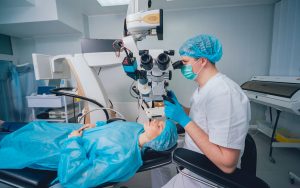Eye Problems Linked To Sunlight and UV Exposure
[/vc_column_text][/vc_column][/vc_row][vc_row][vc_column][vc_column_text]The sun has many benefits to humans and the environment. However, overexposure to the sun’s rays often affects the human body. And your eyes are not safe from these effects. The sun can do a lot of damage to your eyes.And it is not just limited to staring directly into the sun. Sunbathing, playing at the beach on a sunny day, and other fun in the sun activities could affect your eyes.
Below you will find a list of eye conditions linked to sunlight and UV exposure. You will find information on common symptoms and treatments available for patients. Additionally, you will learn how to protect your eyes from these conditions.
1. Aging
Ultraviolet (UV) light penetrates the skin the most. Therefore, prolonged exposure leads to visible signs of aging. Exposure to UV rays is responsible for more than 70% of visible aging signs. Therefore, the longer you expose yourself to UV rays, the quicker you age.
The skin around the eyes retains wrinkles, sunspots, and loosening due to exposure to UV rays. Additionally, squinting under the sun deepens wrinkles, creating crow’s feet wrinkles. Luckily, you can protect your eyes from aging.
First, ensure that you wear sunglasses under the sun. Buy a pair of sunglasses with UV light blocking properties to protect your eyes adequately. Additionally, you should go for a protective sunscreen to protect the skin around your eyes.
Ensure that it can adequately block UV rays. Apply sunscreen under your eyes and over your eyelids, especially if you sunbathe.
2. Cataracts
Long-term sun exposure can, unfortunately, accelerate cataract development. Cataracts are an eye condition characterized by the clouding of the eye’s lens. It affects vision, risking blindness.
The condition is often associated with aging, so some suggest that everyone can develop cataracts if they live long enough. However, studies show that those who constantly expose themselves to the sun are more likely to develop cataracts rapidly.
Cataracts are luckily treatable. The treatment involves removing the affected lens and replacing it with an artificial one. To prevent getting cataracts due to prolonged sun exposure, you can wear UV-blocking sunglasses whenever you are out in the sun.
3. Pinguecula and Pterygium
Pinguecula is a condition that forms a yellow or white bump within the conjunctiva (the layer that covers the white of the eye). This condition is prevalent in people who live in dry, sandy, and dusty areas. Sadly, the condition does not go away on its own.
The eye becomes red and swollen. Doctors treat the condition with eye drops. You will need sunglasses and goggles to protect yourself from sun exposure. Additionally, they will protect you from wind, sand, and dust. It prevents the condition from worsening.
Also known as the third eye condition or surfer’s eye, a pterygium is growth of a pinguecula from the white part of the eye to the cornea. The pterygium is more visible because it is white and wing-shaped, growing over clear tissue. If the tissue continues to grow, it leads to cornea scarring.
This, in turn, affects vision and could mean blindness. Surgery is the only way to remove the growth and prevent vision loss. Sadly, surgery could also mean a higher chance of growth recurrence. However, modern advances reduce this rate.
Pterygium is common among people living near the equator. To prevent it, you must protect your eyes from sun exposure as much as possible.
4. Photokeratitis or a corneal sunburn
This is a painful eye condition similar to a sunburn, only that the cornea sustains sunburns. Corneal sunburn, while temporary, is painful and caused by exposure to UV rays, often from the sun.
It temporarily damages the clear potion of the eye. Snow blindness is a type of photokeratitis that occurs when UV rays are reflected by snow or ice. Again, it is temporary and often occurs in places with a lot of snow.
If you spend a lot of time outdoors, you are more likely to develop photokeratitis. The same goes for people who engage in swimming, mountain climbing, and hiking.
If you spend time or work in a place with a lot of UV light exposure, such as sunlamps or tanning beds, you are also at risk of developing corneal sunburn. Unfortunately, if you live in higher altitudes, you also have greater exposure to UV rays; thus, you are at risk of photokeratitis.
Symptoms of photokeratitis include:
- Redness and pain in the eye
- Swelling around the eye
- Blurry vision
- Tearing
- Eyelid twitching
- Light sensitivity
- Gritty feeling in the eye
- Headaches
- Seeing light halos
- Temporary vision loss (though it is rare and often present in severe cases only)
- Color changes in vision (also very rare)
These symptoms often disappear in 24-48 hours, depending on the severity of sun exposure. However, if you experience symptoms, go indoors, remove your contacts or glasses and place a cold washcloth over your closed eyes. You can also take an oral over-the-counter anti-inflammatory drug such as ibuprofen.
Preventing photokeratitis is all about limiting sun exposure and protecting yourself from UV rays. Invest in UV-blocking sunglasses.
5. Macular degeneration
And finally, macular degeneration occurs due to long-term sun exposure that damages the retina. The retina is the eye’s multiple-layer lining, and at the center is the macula. The macula is the area that provides the clearest vision in the eye. It is where we get central vision.
Macular degeneration causes tissue degradation. This causes central vision loss, leading to blurry vision. It can also cause blank spaces in vision. Patients experience visual distortions and difficulty working in dim light. The condition is most common in people over the age of 50 and those with more sun exposure.
Sadly, there is currently no cure for macular degeneration. All treatment options slow the progression of the disease but cannot undo the damage sustained to the eye. Therefore, you must make efforts to avoid this condition.
Always wear UV-blocking sunglasses to protect your eyes. Additionally, invest in wide-brim hats for limited UV exposure. And if you can, avoid sun exposure between 10:00AM and 4:00PM.[/vc_column_text][/vc_column][/vc_row]




